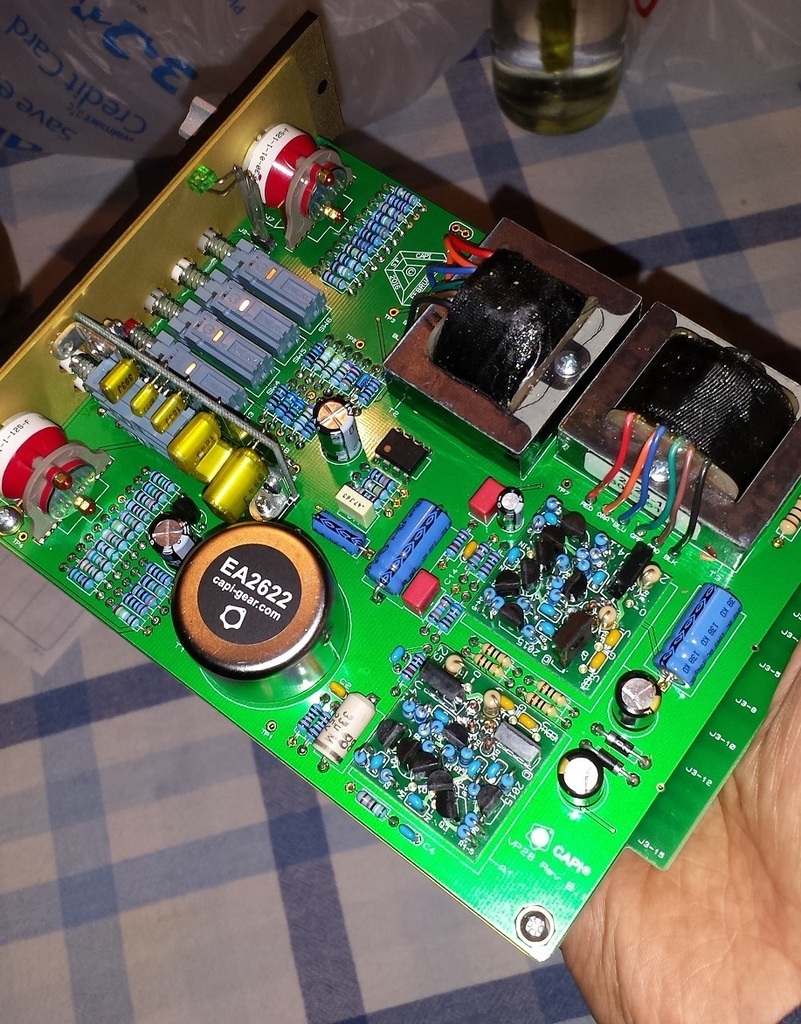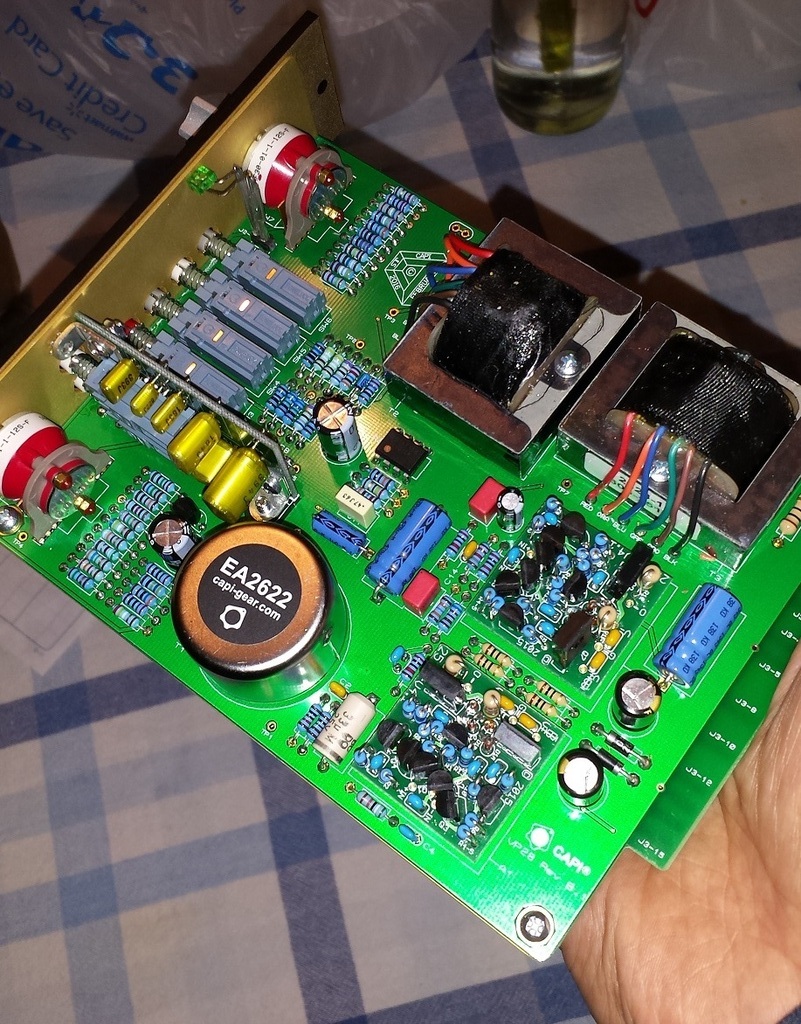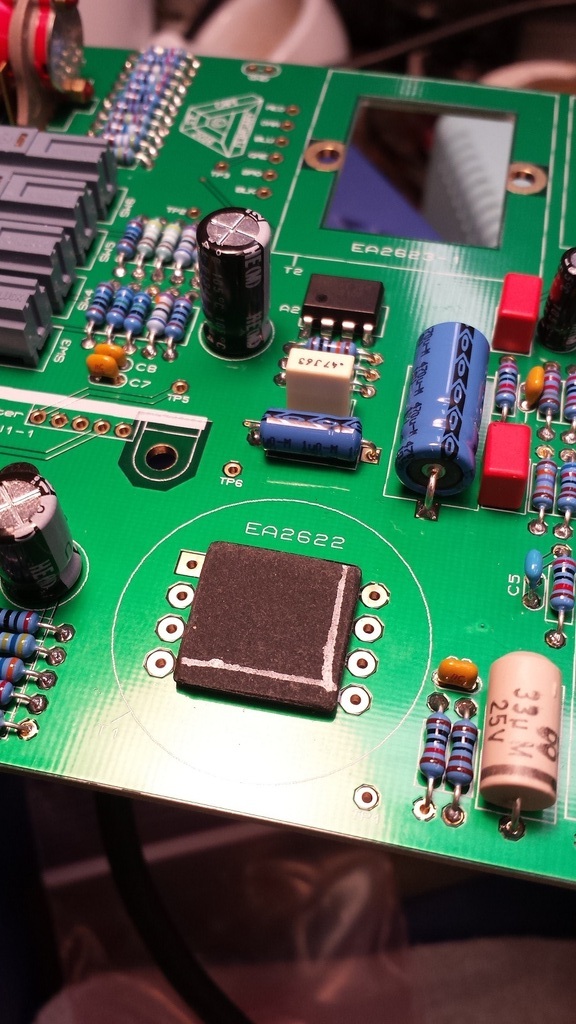I first learned about CAPI gear on the forums. I was looking to dip my toes into the world of API sounds, not fully knowing what that meant. I had heard all the descriptors like punchy, forward mids, aggressive, tight, etc., but wanted to try it out for myself. So many great albums were done on API's, right? I lacked that flavor in my stable, so I clicked the order button on Jeff's website www.capi-gear.com and ordered the VP28 mic preamplifier. It's a two-stage preamp with a lot on board and packed in a 500 series module. I opted for the regular non-Litz wire transformer version with two GAR2520 style op-amp kits. To read up on the more technical aspects of the Litz wire transformers as well as both builds in general, visit THIS LINK
I'd like to start by talking about the hardware. I used to work in manufacturing for a boutique guitar and guitar parts manufacturer. I can tell when something is well-made and when good design is implemented with good materials. The CAPI VP28 (and VP312) have excellent face plates and knobs. They are made of nice, tough metal that is well-finished. The paint and silk-screening are top quality. The knobs, with their unique design, are excellent. My only gripe is that there is no enclosure casing to protect the components during storage or installation/un-installation from a 500 series rack.
The features are plentiful on the VP28. It has an input gain and output "fader", so you can drive it any way you like, especially since the gain and fader both cut and boost in different increments. Because of this, there are many combinations to be had between the two knobs. This also allows you to do something that is usually a bit more difficult to do on an API style preamp - attenuate the output! Getting much color from any single-knob pre usually means adding a pad on the back end of a preamp signal, in-line. However, with the VP28 (and other CAPI gear) you can easily push the input gain until you get the saturation you prefer, while using the fader to attenuate (or even boost) the output.
On the button portion of the VP28 panel from top to bottom you have phase, mic mode/line mode, pad, and 48v. Each has its own LED next to it. There is also a "signal present" indicator LED!
Underneath the main buttons, you have your HPF section, which is a real treat. Aside from my Sebatron Axis which has a 40hz to 400hz HPF on a fully variable potentiometer, I don't have any preamps with such a nice HPF option as the VP28. Yes, it is possible for a hi-pass filter to “sound good”. This one sounds very nice in comparison to some digital HPFs and other preamps I have where there is a single option slope and corner frequency. You have a 6 or 12 db per octave switch, and two buttons. One is for a 40hz corner, and the other is for an 80hz corner. If you press both in, you get a 160hz corner frequency. These options should give you enough to choose from for a wide variety of sources. Kudos to Jeff Steiger who implemented this elegantly.
As far as assembling the kit, the vp28 was my first DIY preamp build, and as such, took me a good few hours. It wasn't painful, though. Just take your time! Expect to take 45 minutes to an hour or even more on the op-amps if its your first time building one. Following Chunger's build guide on the group DIY forum is quite helpful. It can be found here: GROUP DIY BUILD GUIDE CHUNGER. The build guide(s) on the CAPI site are quite good. There are pictures to help identify components visually, and you can also use a multi-meter to check DCR and capacitance. There are nice step-by-step instructions on all details involving switches, buttons, and potentiometers so that you get them installed straight (which is very important!). The op-amps are a little tricky to build as they are using up all of the PCB real estate, but it is very do able with patience, small diameter solder and a long, small soldering iron tip.
On to the sound. THIS is what people have been talking about when it comes to vintage API. It really strikes me as mostly clean at "normal" gain settings. Transients are well represented. To me, there is a slight frequency coloration with the VP28, due in no doubt to its unique circuit and wonderful Ed Anderson transformers. The very top end is slightly reserved, but not lacking in detail, which can be good or bad depending on your wants and needs. I find that the circuit lends a nice warmth to the sound and ever so slightly tames the high-end . The entire mid range is punchy to my ears, with the most forward and aggressive frequencies being the upper mid range. The bass is neatly tucked in at the sub ranges, to my ears, but is still nice and punchy just above that. The overall sound is lean, mean, and punchy, with a touch of warmth. It gives the feeling that the instrument recorded is jumping out of the speaker at you. There is a clarity involved that lets you hear everything so well. If you push the fader down and the gain up, you can start to get some color. To my ears, the low end starts to build up more, and the mid range gets even thicker and punchier. The VP28 has the most clear sounding fatness, when driven, that I have ever heard from a preamp. Usually I find that fatness and warmth come at the price of clarity to a degree, however the VP28 seems to achieve both. The bottom line is that the VP28 is clear, fat, round and punchy, especially when you push it. A little bit of signal compression is introduced and is even visible in the DAW if you really drive the front end. Pushing the amp gain even further brings on some more obvious distortion, but it's quite pleasing and would be nice on certain synth instruments or electronic drums. Keep in mind, the tone of your unit will change depending on which op-amps you use. There are many choices in the 2520 footprint. On the CAPI website you can choose from the GAR918, the predecessor to Deane Jensen's JE-990, the GAR1731, based on the old Melcor 1731, the GAR 2520, based on the original API 2520, as well as Scott Lieber's blue dots and red dots, though those are only available if bundled with a CAPI kit. Just as a side note, when compared to the VP28, the CAPI VP312 has a more extended low and high-end . This is most likely due to the larger transformer they were able to fit in the VP312. Without a side by side comparison, I didn't notice anything lacking in the VP28. Some people seem prefer the VP28 sound to the VP312 as it comes across as a little tighter and a warmer.
The one feature you will find missing on this preamp is a DI jack. You will need to use a DI box with this preamp if you intend to use it in a direct inject manner. I have used my affordable Whirlwind DI for this purpose and it works flawlessly.
I seldom find a preamp or piece of gear to sound bad as my philosophy is that each piece of gear is useful in the right situation. My review may seem a little too positive, so I will add some notes for when I think the VP28 shines and when it might not. These notes are of course based on my humble opinion and taste.
When it shines:
*Rock and roll!
*When you want to feel the sound jump out of the speakers.
*Busy arrangements where a leaner sound helps gain separation in the mix.
*PUNCH*
When another option might be better:
*Acoustic instrument tracks where the the slight aggressiveness is too much.
*Songs that you want to have a wider, somewhat softer sound(a la Neve)
*Songs that you want an ultra clear sound on(a la transformerless designs)
Pros:
*Affordable way to get into API territory (or just some more channels for tracking, even), if you have the time and basic soldering and electronics skills.
*Professional quality and sound
*Feature rich with 6 possible HPF settings, pad, mic/line mode and output attenuator/fader along with the usual polarity flip and 48v phantom power.
Cons:
*No DI option(though the CAPI VP312DI has the option)
In summary, if you'd like a preamp that brings an instrument forward out of the speakers with punch and clarity, you'd be hard pressed to find something better than the VP28. You won't find yourself subtracting as many frequencies to get a clear mix with this amp. Some fatter and warmer designs have more low-mid and bass buildup, which can be nice, yet problematic come mix time. This is less likely a scenario you'll encounter with the VP28 from CAPI. So, get your soldering iron and solder ready and enjoy building yourself a great sounding, high quality preamp.
Aaron Campbell
Please have a listen to the clips in the link below. Feel free to comment or ask questions. In the case of any sampled instruments such as the upright bass on the acoustic waltz and the drums on the rock tune, they were rendered in mono through the VP28 to grab some of it's tone. Everything else was tracked through the VP28 at various clean/pushed/HPF in/out settings. A pinch of reverb was used on the Blues tune, but aside from that, everything is dry. I only used panning and fader rides to mix the tracks.
I apologize for the lack of musicianship if you are particularly sensitive to that. These are real world examples, if you will. I have no business trying to be a multi instrumentalist however that was the only way I could get this done. Thanks for checking it out!
https://app.box.com…"]Clips and Tunes here[/]="https://app.box.com…"]Clips and Tunes here[/]

Comments
A few pictures of my VP28 build. Attach
A few pictures of my VP28 build.




Here are some pics from the build
Here are some pics from the build



